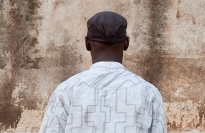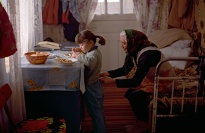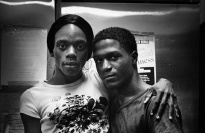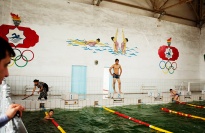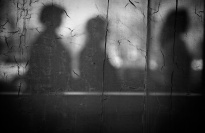About Moving Walls 18
Since 1998, the Moving Walls exhibition series has featured in-depth and nuanced explorations of human rights and social issues that coincide with the Open Society Foundations’ mission. The spring-winter 2011 installment of this series, Moving Walls 18, features seven photographers whose work raises questions about the relationship between identity and home.
What happens, for example, when one’s sexual identity is in conflict with the cultural or religious values of one’s home? Bénédicte Desrus and Tadej Žnidarčič explore this question in the context of Uganda, where homosexuality is illegal and where a bill was introduced in Parliament that, if passed, would impose life imprisonment or the death penalty for homosexual activity.
Desrus shows both sides of this struggle with images of the antigay religious leader behind the bill, as well as his followers, juxtaposed with photographs of gays and lesbians trying to go about their daily lives within a climate of fear and intolerance.
Žnidarčič creates portraits of Ugandan men and women photographed from behind. While the participants in this project hid their faces to avoid persecution for their homosexuality, viewers can also interpret their turned backs as a rejection of homophobic rhetoric. Together, Žnidarčič and Desrus highlight the individual struggles that result when one’s sexual identity threatens the safety of home.
Samantha Box investigates the relationship between sexual identity and home by photographing Sylvia’s Place—New York City’s only shelter for homeless LGBT youth, who are often forced out of their homes after revealing their sexual identities to their families. In contrast to the streets and the discriminatory policies of some social service agencies, Sylvia’s Place provides a unique refuge; residents recreate a sense of home by establishing alternatives to the families and systems of support that they have lost.
Gabriela Bulisova, Abdi Roble, and Andrea Diefenbach address the ever-changing relationship that refugees and migrants have to home, and explore how cultural and national identity are threatened or maintained in the context of new environments.
Bulisova documents Iraqi refugees in the United States who were targeted for retribution as a result of having worked for the U.S. military or other American agencies, NGOs, or companies in Iraq. They have been forced to flee Iraq for their personal safety, but find their adopted country offers only limited protection. Many continue living with fear and instability, as they must hide their identities to protect family members who remain in Iraq and struggle to rebuild their lives in the United States.
Roble explores the notion of home and Somali identity through the perspective of refugees living in Kenya’s Dadaab refugee camp and in the United States. Given their nomadic heritage and the transnational nature of their present-day lives, these Somali refugees define home and foster community not through a physical place, but through the shared experience of maintaining cultural and religious practices along with other Somalis.
Diefenbach documents not the migration of refugees fleeing war, but rather, economic migrants leaving their homes in Moldova in search of employment. Through the still mood of her images, Diefenbach conveys the isolation of the migrants and the children and grandparents left behind, and captures their poignant attempts to hold on to a sense of home and family in spite of their physical distance.
Carolyn Drake explores how landscape and geography help define and maintain a sense of regional and cultural identity for people living in five distinct Central Asian countries previously unified under Soviet rule. Drake follows the Amu Darya and Syr Darya rivers, which have sustained human life for 40,000 years, and shows how the people living alongside these rivers, although divided by geographic and political borders, are connected through their relationship with the landscape.
